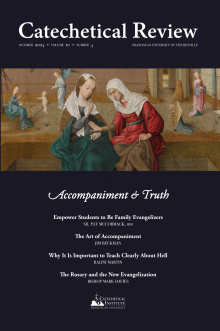 Who am I, really? What makes me who I am? And how much do other people affect who I become? These perennial questions reflect the fact that we are deeply affected by things around us, especially by other people. In some ways, our surroundings helped make us better people, and in other ways, worse. Whether for better or worse, we can wonder who we would be without these influences in our life. It seems hard to argue against how impactful our relationships are, and it raises the question of just how much our relationships define us.
Who am I, really? What makes me who I am? And how much do other people affect who I become? These perennial questions reflect the fact that we are deeply affected by things around us, especially by other people. In some ways, our surroundings helped make us better people, and in other ways, worse. Whether for better or worse, we can wonder who we would be without these influences in our life. It seems hard to argue against how impactful our relationships are, and it raises the question of just how much our relationships define us.
Our Image and Likeness
The search for our own identity goes hand-in-hand with who God is. The Trinity is “the source of all other mysteries, the light that enlightens them,” which includes our own mystery (CCC 234). However, the Trinity is anything but easy to understand, and attempts to resolve the mystery neatly have resulted in numerous heresies in the Church’s history. How can a God whose identity is beyond human understanding or expression help us understand ourselves? How can the unfathomable essence of God help us fathom who we are?
As mysterious as the Trinity is, the Church’s dogma makes one thing clear: our triune God is a relational God. When two things are in relationship with each other, it means that their existence and identities are intertwined. In this sense, none of the persons of the Trinity can be separated from the others (see CCC 255). The Father cannot be apart from the Son, nor the Son apart from the Father, nor the Holy Spirit apart from either.[1] At the same time, a relationship implies distinguishability; it is not possible to say something is unique if there are no differences to tell it apart from something else. The persons of the Trinity are essentially united, but each is distinguished by their relation to each other (see CCC 254–55). The Father is who he is because of the Son, and vice versa. The Holy Spirit is who he is because he is the Spirit of the Father and the Son.[2] To put this more simply, the relationship each person of the Trinity has to the others is both unitive and distinctive: their relationships simultaneously describe their union and their distinction.
Created in God’s image and likeness, human persons bear a certain similarity to the relationality of the divine persons.[3] Being distinct persons, we are nonetheless made for unity. Pope St. John Paul II observes that all human reality can be understood through the lens of relationship. In fact, everything in our lives is composed of four fundamental relationships: with God, with oneself, with others, and with the rest of creation.[4] Sin is ruptured relationship, and reconciliation is its repair. The first sin in Eden is a loss of friendship, and it is echoed in all human strife and injustice.[5] Salvation history, on the other hand, “is the wonderful history of a reconciliation,” a restoration of friendship.[6] Notwithstanding the immense difference between the divine persons and us, we are also constituted by relationships.
The rest of this online article is available for current Guild members.
[1] Eleventh Council of Toledo, in The Christian Faith in the Doctrinal Documents of the Catholic Church, ed. J. Dupuis (New York: Alba House, 1982), 102–6, no. 316.
[2] Ibid., no. 311.
[3] Second Vatican Council, Gaudium et Spes, no. 24.
[4] John Paul II, Reconciliatio et Paenitentia, no. 4.
[5] Ibid., nos. 14–15.
[6] Ibid., no. 4.
[7] Jon Krakauer, Into the Wild (New York: Vintage Books, 2015), 189.
[8] Aristotle, Nichomachean Ethics, bk. 8, no. 1.
[9] Ibid., nos. 6–8.
[10] Ibid., no. 7.
[11] Augustine of Hippo, “Letter 27 to Paulinus,” in Nicene and Post-Nicene Fathers, trans. J.G. Cunningham, ed. Philip Schaff, 1st ser., vol. 1 (Buffalo, NY: Christian Literature Publishing, 1887).
[12] Bernard of Clairvaux, sermon 26, “The Blackness of the Bride Compared to the Tents of Kedar; Bernard’s Lament for His Brother,” V.8-9, in Commentary on the Song of Songs, online at https://ia800702.us.archive.org/11/items/St.BernardOnTheSongOfSongs/
StBernardOnTheSongOfSongsall.wps.pdf
[13] Aelred of Rievaulx, Spiritual Friendship, trans. Lawrence C. Braceland, ed. Marsha L. Dutton, Cistercian Fathers 5 (Collegeville, MN: Liturgical Press, 2010), 1:70.
[14] John Paul II, Redemptoris Missio, no. 26.
This article originally appeared on pages 40-46 of the print edition.
Art Credit: Cinergies Co-Op, Ideas-In-Action.
This article is from The Catechetical Review (Online Edition ISSN 2379-6324) and may be copied for catechetical purposes only. It may not be reprinted in another published work without the permission of The Catechetical Review by contacting [email protected]

















